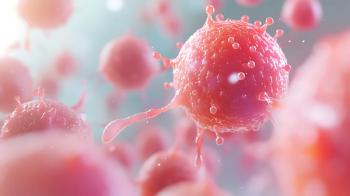
Pharmacy Practice in Focus: Oncology
- August 2020
- Volume 2
- Issue 4
What Pharmacists Need to Know About GISTs
Pharmacists should refer patients to a health care provider if any symptoms could be indicative of a GIST.
GASTROINTESTINAL STROMAL tumors (GISTs) are a rare type of cancer that starts in the digestive tract. GISTs develop in the interstitial cells of Cajal, in the wall of the GI tract. A GIST can also start anywhere along the GI tract. More than half of GISTs (60%) initiate in the stomach, and most others start in the small intestine (35%), but they can also develop in the esophagus, the colon, and the rectum.1,2 To determine the likelihood of growth and/or spread, physicians look at the tumor size, the location in the GI tract, and the tumor’s mitotic rate.1
GISTs are rare and must be differentiated from other, more common cancers that begin in the GI tract, such as adenocarcinomas or squamous cell carcinomas, as well as rarer neuroendocrine tumors and other types of soft tissue sarcomas, such as leiomyosarcomas, malignant peripheral nerve sheath tumors, and angiosarcomas.1
Statistics
Although exact statistics are not documented, an estimated 4000 to 6000 GIST cases are diagnosed annually in the United States. GISTs can develop at any age but are most commonly found in individuals over 50 years and are rarely found in those younger than 40 years.2
Survival Rates
The Surveillance, Epidemiology, and End Results database, maintained by the National Cancer Institute, provides 5-year survival statistics for GIST in the United States. The database groups cancers into stages (Table). The data were collected from 2009 to 2015, with some caveats: The numbers apply to the stage of cancer at diagnosis, and treatments have improved over time, so patients with current diagnoses may have a better outlook than these numbers show.3
Risk Factors
Very few risk factors exist for GISTs, but known ones include the following:
- age over 50 years and
- inherited gene mutations; although most GISTs are not inherited, some are due to these mutations, including primary familial GIST syndrome, neurofibromatosis type 1 (von Recklinghausen disease) and Carney-Stratakis syndrome.4
Causes of GISTs
Most gene mutations related to GISTs are not inherited but rather are acquired or sporadic, occurring for no apparent reason. In most patients with GISTs, the cancer cells have a change in the KIT oncogene. The KIT oncogene directs cells to make the KIT protein, or CD117, which causes the cells to grow and divide.
In 5% to 10% of GISTs, the cancer cells have a mutation in the PDGFRA gene, causing the cells to make too much PDGFRA protein. Most GISTs have a change in either the KIT gene or the PDGFRA gene but not both.
A small number of GISTs, especially in children, have changes in one of the SDH genes. Investigators are studying gene and protein changes in GIST cells to help diagnose and treat these cancers.5
Signs and Symptoms of GISTs
Because many GISTs grow in empty space or are small and slow growing, they may not cause symptoms initially and are often found while a physician is checking for something else, during a routine colonoscopy, for example. Some GISTs are found because they cause bleeding in the GI tract, with symptoms such as vomiting with blood, which may look like coffee grounds; black and tarry stools or red and bloody stools; and a low red blood cell count with accompanying symptoms of fatigue and weakness.
Other GIST symptoms can include abdominal pain or swelling, nausea, vomiting, abnormal fullness after eating very little, appetite loss, weight loss, and, when the tumor is in the esophagus, problems swallowing. A larger tumor may cause obstruction with severe pain and vomiting. A GIST that ruptures can lead to a perforation, requiring emergency surgery.6
Diagnosis
Besides a medical history and a physical exam, patients with GIST will likely need imaging studies. These may include a combination of CT, MRI, and PET scans or barium x-rays. Other tests include endoscopy and colonoscopy with biopsy and blood work.7
Staging
The staging typically used for GIST tumors is the American Joint Committee on Cancer TNM system, which is based on:
- T: tumor, the size of the cancer;
- N: nodes, spread to nearby lymph nodes (uncommon in GIST);
- M: metastasis, spread to distant parts of the body such as the liver, bones, and lungs; and mitotic rate, the rate of cells growing or dividing.
Physicians also need to know whether the tumor can be completely removed, or resected, with surgery. Physicians can completely remove resectable tumors without causing any major health problems. A tumor that is unresectable or marginally/borderline resectable may need to be treated with targeted therapy to try to shrink the tumor enough so that it can be surgically removed.8 Patients with GIST may be treated by a medical oncologist, a surgical oncologist, a gastroenterologist, and other health care professionals.
Surgery
A GIST that has not spread is usually treated with surgery, with the goal being to remove all the cancer. The type of surgery depends on the location and sizeof the tumor.9
Targeted Drug Therapies
Traditional chemotherapy is usually not helpful for GIST tumors. Instead, clinicians use precision drugs to treat GISTs by targeting proteins in GIST cells. Tyrosine kinase inhibitors (TKIs) are used in GIST to target proteins such as KIT and PDGFRA.10
Ablation and Embolization
If the GIST has spread to the liver and surgery is not an option, ablation and embolization may be considered. With ablation, tumors are destroyed using extreme heat or cold or chemicals. With embolization, the goal is to reduce or block blood flow to cancer cells in the liver.17
Chemotherapy and Radiation
Traditional chemotherapy and radiation are rarely used because of their lack of efficacy in GISTs. Imatinib and other TKIs are considered chemotherapy, as they are used to treat cancer. Radiation may sometimes be used to treat symptoms such as bone pain.18,19
The Pharmacist’s Role
Because GIST tumors are rare, pharmacists may not feel comfortable speaking to patients about them. However, as trusted and knowledgeable health care professionals, pharmacists can help patients by providing medication counseling as well as referrals to local cancer support groups. Importantly, pharmacists should refer patients to a health care provider if any symptoms could be indicative of a GIST, such as unusual bleeding; pain; black, tarry stools; trouble swallowing; and other abdominal symptoms.
KAREN BERGER, PHARMD, is a pharmacist at an independent pharmacy in northern New Jersey.
REFERENCES
- What are gastrointestinal stromal tumors? American Cancer Society. Updated December 1, 2019. Accessed July 12, 2020. https://www.cancer.org/cancer/gastrointestinal-stromal-tumor/about/what-is-gist.html
- Key statistics for gastrointestinal stromal tumors. American Cancer Society. Updated December 1, 2019. Accessed July 12, 2020. https://www.cancer.org/cancer/gastrointestinal-stromal-tumor/about/key-statistics.html
- Survival rates for gastrointestinal stromal tumors. American Cancer Society. Updated January 8, 2020. Accessed July 12, 2020. https://www.cancer.org/cancer/gastrointestinal-stromal-tumor/detection-diagnosis-staging/survival-rates.html
- Gastrointestinal stromal tumor risk factors. American Cancer Society. Updated December 1, 2019. Accessed July 12, 2020. https://www.cancer.org/cancer/gastrointestinal-stromal-tumor/causes-risks-prevention/risk-factors.html
- What causes gastrointestinal stromal tumors? American Cancer Society. Updated December 1, 2019. Accessed July 12, 2020. https://www.cancer.org/cancer/gastrointestinal-stromal-tumor/causes-risks-prevention/what-causes.html
- Signs and symptoms of gastrointestinal stromal tumors. American Cancer Society. Updated December 1, 2019. Accessed July 12, 2020. https://www.cancer.org/cancer/gastrointestinal-stromal-tumor/detection-diagnosis-staging/signs-symptoms.html
- Tests for gastrointestinal stromal tumors. American Cancer Society. Updated December 1, 2019. Accessed July 12, 2020. https://www.cancer.org/cancer/gastrointestinal-stromal-tumor/detection-diagnosis-staging/how-diagnosed.html
- Gastrointestinal stromal tumor stages and other prognostic factors. American Cancer Society. Updated December 1, 2019. Accessed July 12, 2020. https://www.cancer.org/cancer/gastrointestinal-stromal-tumor/detection-diagnosis-staging/staging.html
- Surgery for gastrointestinal stromal tumors. American Cancer Society. Updated December 1, 2019. Accessed July 12, 2020. https://www.cancer.org/cancer/gastrointestinal-stromal-tumor/treating/surgery.html
- Targeted drug therapy for gastrointestinal stromal tumors. American Cancer Society. Updated May 18, 2020. Accessed July 12, 2020. https://www.cancer.org/cancer/gastrointestinal-stromal-tumor/treating/targeted-therapy.html
- Gleevec - imatinib mesylate tablet. DailyMed. Updated July 10, 2020. Accessed July 12, 2020. https://dailymed.nlm.nih.gov/dailymed/drugInfo.cfm?setid=211ef2da-2868-4a77-8055-1cb2cd78e24b
- Balachandran VP, DeMatteo RP. Gastrointestinal stromal tumors: who should get imatinib and for how long? Adv Surg. 2014;48(1):165-183. doi:10.1016/j.yasu.2014.05.014
- Sutent - sunitinib malate capsule. DailyMed. Updated June 10, 2020. Accessed July 12, 2020. https://dailymed.nlm.nih.gov/dailymed/drugInfo.cfm?setid=43a4d7f8-48ae-4a63-9108-2fa8e3ea9d9c
- Stivarga - regorafenib tablet, film coated. DailyMed. Updated July 13, 2020. Accessed July 16, 2020. https://dailymed.nlm.nih.gov/dailymed/drugInfo.cfm?setid=824f19c9-0546-4a8a-8d8f-c4055c04f7c7
- Qinlock - ripretinib tablet. DailyMed. Updated May 15, 2020. Accessed July 12, 2020. https://dailymed.nlm.nih.gov/dailymed/drugInfo.cfm?setid=9f18e462-03dd-4296-a02a-a0577e3ee78d
- Ayvakit - avapritinib tablet, film coated. DailyMed. Updated January 21, 2020. Accessed July 12, 2020. https://dailymed.nlm.nih.gov/dailymed/drugInfo.cfm?setid=645c887c-8cd4-4623-8da9-ac223d71a8b9
- Ablation and embolization to treat gastrointestinal stromal tumors. American Cancer Society. Updated December 1, 2019. Accessed July 12, 2020. https://www.cancer.org/cancer/gastrointestinal-stromal-tumor/treating/ablation-embolization.html
- Chemotherapy for gastrointestinal stromal tumors. American Cancer Society. Updated December 1, 2019. Accessed July 12, 2020. https://www.cancer.org/cancer/gastrointestinal-stromal-tumor/treating/chemotherapy.html
- Radiation therapy for gastrointestinal stromal tumors. American Cancer Society. Updated December 1, 2019. Accessed July 12, 2020. https://www.cancer.org/cancer/gastrointestinal-stromal-tumor/treating/radiation-therapy.html
Articles in this issue
over 5 years ago
Managing Oral Oncolytics During the COVID-19 Pandemicover 5 years ago
Brown Bag Consult®: Chemotherapy Recovery With Heart Problemsover 5 years ago
Apixaban: A New Treatment Option for Cancer-Associated VTEover 5 years ago
An Overview of CAR T-Cell Therapies and Adverse Effectsover 5 years ago
What Does Excellence in Oncology Pharmacy Look Like?over 5 years ago
Stability of Rare TP53 Comutations in Patients With AMLNewsletter
Stay informed on drug updates, treatment guidelines, and pharmacy practice trends—subscribe to Pharmacy Times for weekly clinical insights.













































































































































































































